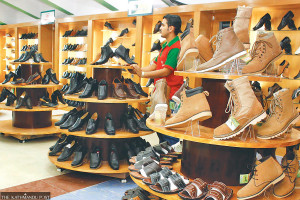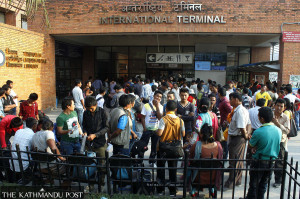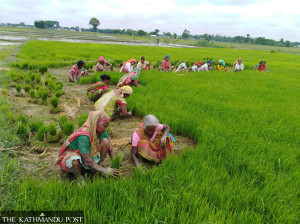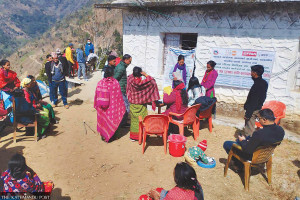 16.12°C Kathmandu
16.12°C KathmanduMoney
A Chitwan couple’s masyaura and gundruk find fans at home and abroad
Dhruba and Ambika Dhital, a couple from Bharatpur, brand, and promote their products.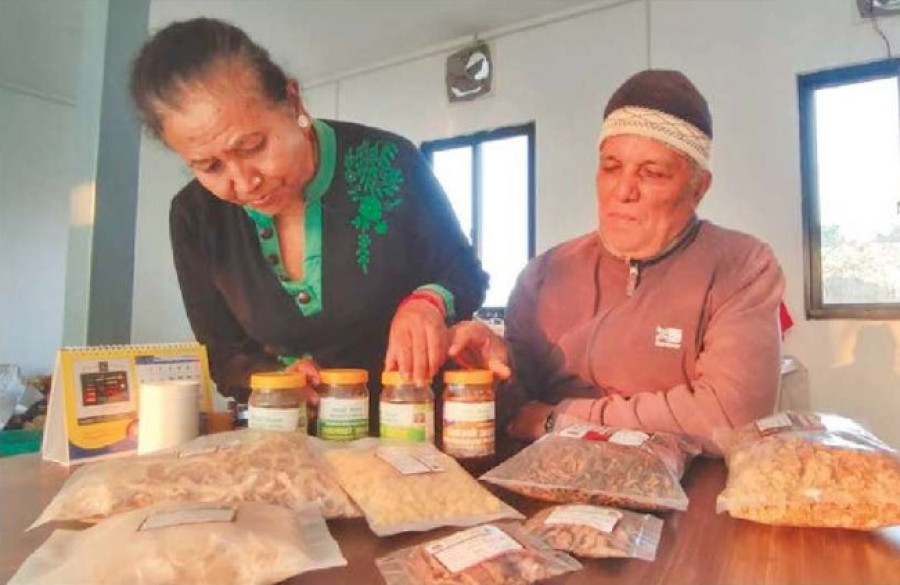
Ramesh Kumar Paudel
Six years ago, Dhruba and Ambika Dhital, a couple from Bharatpur, started making masyaura and gundruk after returning from abroad, where they saw a huge business scope for Nepal’s traditionally preserved food items, which have otherwise become rare on plates today.
After starting in 2018, in six years, Dhruba, 69, and Ambika, 63, have seen their business thrive as an established brand, with a large loyal customer base at home and abroad.
Their products now have a strong market reputation.
Masyaura, fermented sun-dried vegetable balls, are made with a combination of various minced vegetables.
Gundruk is dehydrated and fermented leafy greens.
Traditionally, in most of Nepal’s villages, masyaura is an alternative nutritious food item when fresh vegetables aren’t available round the year.
“Many people nowadays come to my house at Shanti Marga to buy gundruk and masyaura,” said Ambika. “We are busy taking orders.”
“Last Friday, one of my close relatives came early in the morning. She wants to send gundruk and masyaura to her children in the US,” said Ambika.
Not only abroad, but at every fair held in Chitwan and nearby places, people look for Dhitals’ stall. In a recently-concluded festival in Ratnanagar, their stall was jam-packed with customers.
“The couple’s masyaura and gundruk have a distinct flavour. They are now one of the much-sought products in Chitwan,” said Surya Neupane, president of the Chitwan Association of Industries.
Dhitals’ son and daughter-in-law are in Australia while their daughter and son-in-law live in London, the UK.
“Both in London or Australia, we spotted gundruk and masyaura in department stores. We bought them and cooked, but these traditionally preserved food items tasted quite strange,” said Ambika.
When she visited Australia in 2016, she knew how the demand for traditionally preserved food items was increasing among the Nepalis living there.
Dhruba, a retired overseer of the Department of Irrigation, and Ambika, who has a diploma in fashion design, said when they returned from Australia, a new idea struck them.
They decided to become entrepreneurs.
The idea worked.
The couple registered a company, ‘Mandro Nepal’, and produced 100 kg of masaura and gundruk in the first lot in April 2018. In the last six years since, their small enterprise is now well-known.
“My father and grandfather worked in the Nepal Army. I did not follow in their footsteps and chose to be an overseer instead,” said Dhruba.
Gundruk has a long tradition in Nepal. “When King Prithvi Narayan Shah was uniting Nepal, during the war, his army used to carry gundruk and soybean for food,” said Dhruba.
“Orders keep pouring in and are steadily increasing,” said Ambika.
“Before the Covid pandemic, we made a good income. We earned around Rs2 million in a year,” Dhruba said. “But the pandemic badly hit business. We even had to dispose of the unsold gundruk and masyaura.”
“That was indeed a bad time.”
After the pandemic, the business started to recover.
“The annual revenue is now Rs3 million,” said Ambika. “We have a variety of products.”
Currently, Mandro Nepal is selling masyaura made by mincing taro (pindalu) and mixing it with flour of black lentils (mas ko dal). The enterprise also produces masyaura made of yellow lentils (moong dal).
Apart from gundruk, which is made from mustard leaves, they also produce sinki, dried and fermented radish.
Sinki is considered good for digestion and helpful in curing diarrhoea and stomach pains.
They also produce dried mushrooms and vegetable fern, and gooseberry pickles.
“Every vegetable can be dried and kept for a longer period. We can cook them whenever we want to eat,” Ambika said.
The business requires a small investment. But to produce products on a commercial scale, based on the demand, the enterprise has machines for chopping, drying, making paste or powder, packaging and labelling.
Ambika has installed seven solar dryers and one electrical dryer.
“We have so far invested Rs3 million. We have also received machines in grants.”
The microenterprise has employed four people.
Ambika has a farm that produces taro leaves, a green leafy vegetable high in potassium, folate, and vitamins C and A.
She produces taro leaves on 10 kattha (2,700 square metres) and sources taro roots from hill districts.
“I buy leafy vegetables from farmers in Chanauli in west Chitwan.”
“The microenterprise has not only preserved traditional foods but also supported employment,” said Neupane of the Chitwan Association of Industries.
Agro economists say traditional fermented foods that supplemented nutritional voids in the past decades are slowly disappearing from Nepali plates, due to the domination of highly-processed imported foods.
According to a research paper entitled Traditional Indian fermented foods: a rich source of lactic acid bacteria, sinki and gundruk have many health benefits.
As well as being rich in lactic acid, gundruk is said to aid milk production during lactation for mothers, while sinki helps cure diarrhoea and stomach pains, the study says.
Lactic acid additionally helps relieve diarrhoea and boosts the immune system.
Traditional fermented foods have been popularly consumed and form an integral part of our diet since early history.
The research paper says fermentation evolved as a preservation or prevention technique during lean periods to counter spoilage of food products. It is one of the oldest and most economical methods for producing and preserving foods.
In addition to preservation, fermented foods can also enhance flavour, increase digestibility, and improve nutritional and pharmacological values. Lactic acid bacteria perform an essential role in the preservation and production of wholesome fermented foods.
With more and more Nepalis choosing to live abroad, Ambika says that the demand would grow by leaps and bounds if the traditional fragmented foods can be better marketed.
“Forty percent of masaura and gundruk which we produce are sold in local markets. We export the other 60 percent,” said Ambika. “Business is growing both in domestic and international markets.”




1.jpg)








